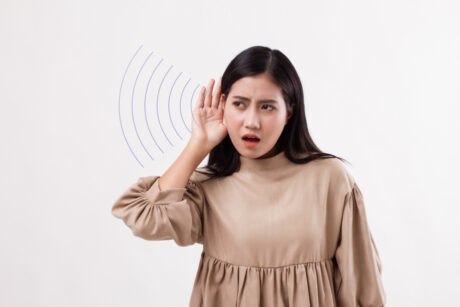Sensorineural deafness is a hearing loss that occurs from damage to the inner ear, which is a nerve that runs from the ear to the brain (auditory nerve).
The ear consists of inner, middle, and external structures. The eardrum and the tiny bones (hammer, anvil, and stirrup) in the ear conduct sound from the eardrum to the cochlea.
The general perspective of how hearing works
You first need to know what generally happens inside your ear when you hear. Let’s take for example, a loud gunshot or a loud blast:
First, the sound reaches your eardrum. The eardrum vibrates and pushes three tiny bones of your middle ear. These bones force the sound to the cochlea, a fluid-filled compartment in your inner ear. The cochlea is lined with little hairs that shake or vibrate when the sound waves beat them. These hairs transform the sound waves into an electrical signal which gets transmitted to the brain. The brain discovers that a gunshot or blast is near you. Depending on how loud the sound is, your ears will react to it.
Causes of Hearing Loss
Hearing loss can have many various causes. Pressure changes, loud noises, or a head injury can all harm the fragile structures in your ear that permit you to hear.
Infections like measles, mumps, and meningitis can also hurt the ear. Occasionally earwax can build up in your ear and obstruct your hearing like a cork.
You may also slowly lose your hearing as you get older, even if you don’t have an ailment or injury. The injury or other concern to your outer or middle ear is called conductive hearing loss.
Sensorineural hearing loss (SNHL) at birth
Sensorineural deafness at birth (congenital) is most often due to:
- Infections a mother passes to her baby in the womb (rubella, toxoplasmosis, herpes)
- Hereditary syndromes (Genetic)
SNHL may form in children or adults later in life (acquired) due to the following:
- Meniere disease
- The condition of the blood vessels
- Age-related hearing loss
- Injury
- Infections such as mumps, meningitis, scarlet fever, and measles
- Immune disease
- Tumors, such as acoustic neuroma
- Loud noises or sounds or working around loud noises every day
- Use of certain medicines
In some cases, the cause is unknown.
If you have SNHL, you may be able to hear through assistive listening devices, such as hearing aids or cochlear implants.
Treating SNHL hearing loss
Visit The Listening Lab for a hearing test if you notice that sounds are vague and you can’t easily understand what people are saying. Our audiologists will inspect your ears and give you an audiometry test to check the type of hearing loss and amount of hearing you have lost.
They may also refer you to an ENT to perform imaging tests such as a CT or MRI scan if you’ve had a head injury. A hearing aid can intensify sounds to assist you in hearing more clearly.
Hearing aids today are so tiny they’re barely detectable. If you have a buildup of earwax, an ear syringe filled with clean, warm water can help flush the buildup. Contact an audiologist for a hearing consultation. You can reverse hearing loss due to a concern in your external or middle ear. Guard your hearing by avoiding loud noises and wearing earplugs when you need to be exposed to loud sounds.
About The Listening Lab
Listening Lab is a home-grown company whose mission is to help our clients restore their hearing to enjoy the life that they desire. Experiencing hearing loss can be detrimental to one’s quality of life. Hence we commit to providing high-quality hearing solutions.
Our hearing solutions include hearing tests and treatment and prescribing hearing aids. Clients may come to get their hearing checked, and we will assess whether hearing aids are required.
If hearing aids are required, clients can choose from a variety of the best hearing aid brands we provide. Each of the products offers unique features that complement daily use and perform well in helping our clients enjoy the life that they desire.










